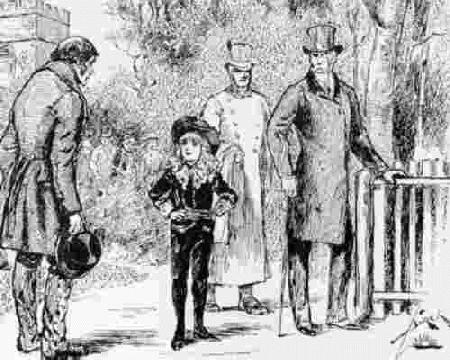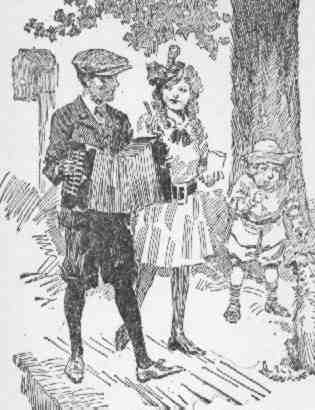
Figure 1.--Higgins thanks the Erol for his kindness, not know Cedric was responsible. The velvet suit and lace collar became a popular party suit for American and European boys.


Figure 1.--Higgins thanks the Erol for his kindness, not know Cedric was responsible. The velvet suit and lace collar became a popular party suit for American and European boys. |
Many famous liteary characters are boys, especially in American and English literature. Many American novels are set around a boy's experiences or have boys as important characters. The costuming of these
characters, especially the contemporary books, offer important insights into historic costuming. This is especially true of the books with illustrations. Less useful, but more available, are modern books
written with histoical settings or recent editions of historical books with modern illustrations.
American authors appear to have focused on byhood more than authors in other countries, except England. There are many important American boyhood characters, but few from other countries--except England. Perhaps
my greater faniliarity with American literature. Hopefully HBC visitors from other countries can assist us on this issue.
Some of the most famous American characters are:
Brown, Buster: The comic strip character Buster Brown was one of the
most popular characters in turn-of-the-century America. His characteristic wide-brimmed sailor hat, red tunic, floppy bow, and strap shoes worn with bangs made
the tunics worn by boys at the time an even more popular style.
Erol, Cedric: Cedric Erol is of course the main character in
Francis Hobson Bennett's Little Lord Fauntleroy, published in
1885. This novel probably had more influence on boy's fashions than any
other single book. While Bennett provided limited describition's of
Cedric's outfits, the accompamying illustrations by Reginald Birch caused a
sensation. For
three decades, Americam, British, French, and other European boys were
outfitted in the velvet kneepants outfits harening back to the
Van Dyck
paintings of 17th Century with large lace and ruffled collars.
Finn, Huckleberry: Mark Twain's saga of the pre-Civil War American boyhood is one of the classic's of American literature. The book was
a sequal to Twain's imensely popular Tom Sawyer and was published in 18??). It was, however, a very different book. Twain arrgues
powefully for the esential humanity of Black Americans. Strangely the book is often a target of Black groups demanding it be removed from school
libaries and required reading lists. The book is set in the 1840s and uses realistic dialog of the day. Huckleberry's characteridtiv bare feet and roughbclothes
are a realistic look at how the average boy in pre-Civil War America
dresed.

Figure 2.--Booth Tarkington's Penrod was a delightfully humerous look at American boyhhod in the 1910s. Penrod was about 11 going on 12 and wore knickers buckled just above the knee. |

Figure 3.--. |
Navigate the HBC literary pages' Historical Clothing Web Site:
[Return to the main Main literary page]
[England]
[Netherlands]
[United States]
Navigate the Boys' Historical Clothing Web Site:
[Introduction]
[Chronology]
[Clothing styles]
[Biographies]
[Bibliographies]
[Contributions]
[Movies]
[Activities]
[Countries]
[Boys' Clothing Home]